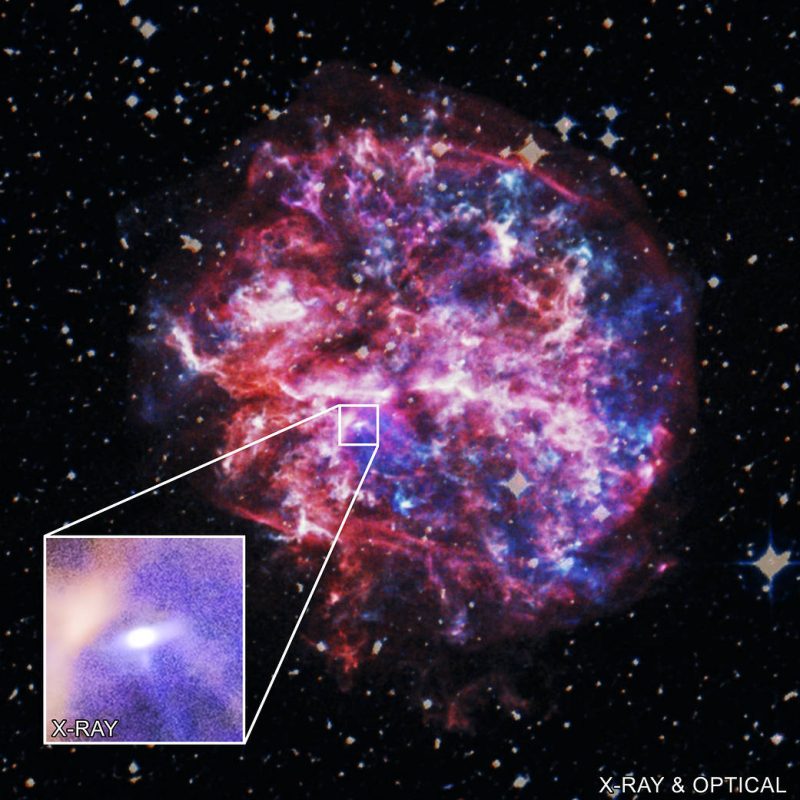
Speedy pulsar
A young pulsar is blazing through the Milky Way at a speed of over a million miles per hour (1.6 million km/h). This stellar speedster, witnessed by NASA’s Chandra X-ray Observatory, is one of the fastest objects of its kind ever seen. This result teaches astronomers more about how some of the bigger stars end their lives.
Pulsars are rapidly spinning neutron stars that are formed when some massive stars run out of fuel, collapse, and explode. This pulsar is racing through the remains of the supernova explosion that created it [now known as the supernova remnant G292.0+1.8], located about 20,000 light-years from Earth. Xi Long of the Harvard-Smithsonian Center for Astrophysics (CfA), who led the study, said:
We directly saw motion of the pulsar in X-rays, something we could only do with Chandra’s very sharp vision. Because it is so distant, we had to measure the equivalent of the width of a quarter about 15 miles (24 km) away to see this motion.
To make this discovery, the researchers compared Chandra images of G292.0+1.8 taken in 2006 and 2016. From the change in position of the pulsar over the 10-year span, they calculated it is moving at least 1.4 million miles per hour (2.3 million km/h) from the center of the supernova remnant [in the image above, the pulsar is moving to the lower left]. This speed is about 30% higher than a previous estimate of the pulsar’s speed that was based on an indirect method, by measuring how far the pulsar is from the center of the explosion.
A southern supernova
The newly determined speed of the pulsar indicates that G292.0+1.8 and its pulsar may be significantly younger than astronomers previously thought. Xi and his team estimate that G292.0+1.8 would have exploded about 2,000 years ago as seen from Earth, rather than 3,000 years ago as previously calculated. Several civilizations around the globe were recording supernova explosions at that time, opening up the possibility that G292.0+1.8 was directly observed. Co-author Daniel Patnaude, also of the CfA, said:
We only have a handful of supernova explosions that also have a reliable historical record tied to them. So we wanted to check if G292.0+1.8 could be added to this group.
However, G292.0+1.8 – located in our sky in the direction of the southern constellation Centaurus – is below the horizon for most Northern Hemisphere civilizations that might have observed it. And there are no recorded examples of a supernova being observed in the Southern Hemisphere in the direction of G292.0+1.8.
Giving the speedy pulsar its ‘kick’
In addition to learning more about the age of G292.0+1.8, the research team also examined how the supernova gave the pulsar its powerful kick. There are two main possibilities, both involving material not being ejected by the supernova evenly in all directions. One possibility is that neutrinos produced in the explosion are ejected from the explosion asymmetrically. And the other is that the debris from the explosion is ejected asymmetrically. If the material has a preferred direction the pulsar will be kicked in the opposite direction because of the principle of physics called the conservation of momentum.
The amount of asymmetry of neutrinos required to explain the high speed in this latest result would be extreme, supporting the explanation that asymmetry in the explosion debris gave the pulsar its kick. This agrees with a previous observation that the pulsar is moving in the opposite direction from the bulk of the X-ray-emitting gas.
The energy imparted to the pulsar from this explosion was gigantic. Although only about 10 miles across, the pulsar’s mass is 500,000 times that of Earth, and it is traveling 20 times faster than Earth’s speed orbiting the sun. Co-author Paul Plucinsky, also of CfA, said:
This pulsar is about 200 million times more energetic than Earth’s motion around the sun. It appears to have received its powerful kick just because the supernova explosion was asymmetric.
What is its true speed?
The true speed through space is likely to be higher than 1.4 million miles per hour (2.3 million km/h) because the imaging technique only measures motion from side to side, rather than along our line of sight to the pulsar. An independent Chandra study of G292.0+1.8 led by Tea Temim of Princeton University suggests that the speed along the line of sight is about 800,000 miles per hour (1.3 million km/h), giving a total speed of 1.6 million miles per hour (2.6 million km/h). A paper describing this work was recently accepted for publication in The Astrophysical Journal.
The researchers were able to measure such a small shift because they combined Chandra’s high-resolution images with a careful technique of checking the coordinates of the pulsar and other X-ray sources by using precise positions from the European Space Agency’s Gaia satellite.
The latest work by Xi and team on G292.0+1.8 was presented at the 240th meeting of the American Astronomical Society meeting in Pasadena, California. The results are also discussed in a paper that has been accepted into The Astrophysical Journal and is available online.
Bottom line: Astronomers compared images taken 10 years apart by the Chandra X-ray Observatory to learn that a speedy pulsar inhabits a known supernova remnant.
Source: The Proper Motion of the Pulsar J1124-5916 in the Galactic Supernova Remnant G292.0+1.8











